In the art and other activities of the intellectuals, artists and architects associated with the Independent Group – who formally met at the Institute of Contemporary Arts (ICA) in London between 1952 and 1955, and who continued to collaborate into the early 1960s – two rather different tendencies are evident. There is the privileging of unvarnished facts and raw materiality associated with brutalism (the modern architectural movement which developed in the 1950s), and there is also a proto-pop fascination with the visual culture of the modern mass media.1 Eduardo Paolozzi’s early figurative sculptures, the concatenations of raw matter and mechanical debris of industry he was producing when the Independent Group was active in the mid-1950s, may seem quite alien to the mass media-orientated coloured screenprints he fashioned in the 1960s. However, to conclude that a clear distinction can be made between an earlier brutalist aesthetic and a later pop one would seriously misrepresent both the Independent Group’s mindset and Paolozzi’s project as an artist. As different as these tendencies might appear in purely visual terms, they are informed by certain shared concerns and artistic procedures. Pop has its monstrosities, and brutalism its ultra-modern imaging aspects. There is an intermingling of brutalist materialism and pop ‘savviness’ with an intellectual probing of living conditions in the modern world throughout the intriguing, hybrid body of work Paolozzi produced in the wake of his involvement with the Independent Group. Perhaps more than any of his Independent Group colleagues, Paolozzi demonstrated an unusual diversity and breadth of cultural reference, making striking transitions across the brutalist-pop divide over the course of his career.
Paolozzi’s engagement with media culture started in the late 1940s when he began putting together informal proto-pop collages for an archive of printed images from books and magazines. However, he did not publically display this interest until much later, aside from his presentation of materials from this archive at the ICA in April 1952.2 At this early stage his collages featured as part of an informal anthology of the printed imagery created by the modern mass media rather than as art, a status very much in tune with the non-art ethos of the Independent Group. These collages first emerged in public as works of art in Paolozzi’s retrospective at the Tate Gallery in 1971, after which he selected a group to issue as screenprinted reproductions in a series entitled Bunk, which appeared in 1972.3
The medium of screenprinting – the technical possibilities of which were being exploited by a number of artists, such as Andy Warhol, in the 1960s – was central to Paolozzi’s engagement with the image world of the modern mass media. On the one hand, the fine-grained screen used for printing, onto which a photographed image of the montage created by the artist was transferred by photomechanical process, allowed for high definition reproduction, where the crisply rendered forms and uniform fields of colour had the look of mechanically produced, rather than hand-made, work. The screenprinting process could also be exploited to experiment with visual transformations or modifications of the source material. Light-dark registers, for example, could be muted, or made more crudely contrasting, using filters in the photomechanical process of creating the image fixed onto the screen. A feature of screenprinting that Paolozzi particularly exploited was the possibility it offered for varying the colour registration from imprint to imprint. Each colour was printed using a separate screen in which only those areas taking the colour concerned would remain unblocked with resin and porous to the coloured pigment. Areas printed in one colour in an imprint could then be changed to a different colour using the same screen in a subsequent imprint. In this way, colour registration could be systematically recomposed.4 Technically, this was a demanding procedure, and Paolozzi depended on the expertise of Chris Prater at Kepra Prints to realise the effects he was seeking: in fact, Prater’s involvement made Paolozzi’s more elaborate series of screenprints, such as As Is When 1964–5, into something of a collaborative effort. Paolozzi exploited the resources of screenprinting in a number of ways – in the printing process, strict mechanical reproduction could be integrated with selective modification and transformation, while an assemblage made up of very diverse materials – hand-crafted, and found images and motifs – could be given a more uniform or integrated visual appearance.
New brutalism
The Independent Group was not a conventional artistic movement, and did not produce any single declaration of aesthetic principle – indeed, this would have been be at odds with its commitment to open, multi-media experimentation. The closest to an attempt to characterise a collective agenda is the article ‘The New Brutalism’ (1955) by Reyner Banham. The first of the two plates accompanying the article offers an intriguing juxtaposition of materially saturated brutalist imagery and seemingly lightweight and semi-transparent modernist architectural form.5 Although largely architectural in focus, the article characterised brutalism as a broader trend that was, perhaps, most clearly apparent in recent visual art.6 Banham summed up his case for new brutalism by highlighting what he saw as its three defining characteristics: ‘1, Memorability as Image; 2, Clear exhibition of Structure; and 3, Valuation of materials “as found”.’7 Structure was the most exclusively architectural of the three. Even so, the rejection it entailed for Banham of geometrically ordered artistic form, in favour of configurations dictated by processes of fabrication and patterns of living, had important echoes in the art and personal ambitions of a younger generation of artists. The other criteria – image quality and valuation of materials ‘as found’ – are more evidently not just about architecture, related as they were by Banham to brutalist tendencies in painting,8 and they also prefigure the characteristics of pop art to which he later became attracted.
What drew Banham to brutalist tendencies in art was the radically aformalist, anti-classical alternative they offered to mainstream modernist abstraction; their engagement with (and exposure of) the material qualities of the chosen medium (be it paint or burlap); and also their image quality, a quality not imposed on the work from the outside, but inherent in a work’s constitution as ‘the thing itself, in its totality, and with all its overtones of human association’.9 It is significant that Banham lighted on the term, ‘as found’, which differentiated what he was striving for from conventional understandings of both the found or readymade object and the aesthetics of truth to materials.

Fig.1
Hunstanton School in Norfolk, completed in 1954, designed by Alison and Peter Smithson
The era’s new architecture was illustrated in the article by, among other items, an image of the Hunstanton School in Norfolk designed by Alison and Peter Smithson, which is rather similar in appearance to the modernist purity of Mies van der Rohe’s work (fig.1).10 In this, and other designs of the time, buildings were constructed from industrially prefabricated units (for example, steel beams, concrete slabs and blocks, and bricks), not untreated raw materials, which were shaped to fulfill a particular structural purpose. The exposed steel beams that provided the framing support for some of this architecture were not literally bits of found metal but were shaped to do a specific job efficiently. All the same, their basic material properties were not obscured to fit a particular aesthetic look. In the case of the visual arts that interested Banham, such ‘as foundness’ had to do with exploiting and making apparent the material properties of medium, and experimenting with non-art materials. It also had implications for forms of art that Banham did not discuss, such as montage and later pop art, in which the materials incorporated were images circulating in the larger visual culture. The ‘as foundness’ in this case either had to do with the basic, readily recognisable form of a found image the artist chose to deploy, or with material processes of image and pattern formation operating in the modern media. This distinction between the ‘as found’ and the readymade and found object was to be important for Paolozzi, even in his later more pop-like work, which deployed pre-fabricated printed images, visual patterns and texts.
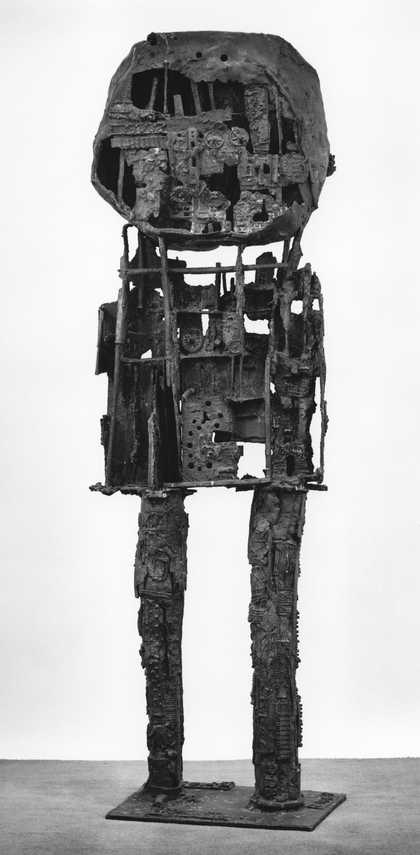
Fig.2
Eduardo Paolozzi
St. Sebastian No.2 1957
Bronze 2003 x 711 x 508 mm
Solomon R. Guggenheim Museum, New York
© The Eduardo Paolozzi Foundation
Paolozzi’s sculptural creations of the 1950s, such as St. Sebastian No.2 1957 (fig.2), were, like Banham’s preferences in the visual arts at this moment, very much rooted in postwar art informel– a term applied to works, mainly by European artists, that broke with previous conceptions of order and composition – and the taste for a brutalist materialism associated with the work of painters such as Jean Dubuffet.11 The fabrication of the sculpture involved working with lumps of clay and wax. Even so, found elements did play a significant, if not preponderant, role. The work is not just a single sculptural shape. Seen close to its surfaces, even some of its body parts take on the appearance of assemblages of imprints, and casts of bits and pieces of modern machinery. Washers, nuts, small gears and fragments of the insides of mechanized gadgets were impressed into slabs of wax from which the model for the sculpture’s head was assembled, while the torso replicates a structure of metal rods and castings collaged together with clay, and the surfaces of the pillar-like legs are corroded (like the face) with castings from found scraps of industrial metal parts.12 The associations Paolozzi conjured up in his commentary on the work, as part of a lecture he delivered in 1958, elaborate on the raw materiality of its more brutalist aspects, and also pick up on the elision it effects between organic body and personhood: ‘the METAMORPHOSIS OF A COLUMN INTO A FIGURE/INTO A TOWER A MAZE OF PART AND PERSON/ like an avant-garde POWER PLANT’. He envisaged the sculpture as a curiously hybridised, evocative presence – or alternatively, as a powerfully destructive natural force, a ravaged landscape, an automaton with its inner workings exposed, an archaic relic, or an enigmatic sign, both ‘mechanism’ and ‘antimechanism’:13
The torso like a tornado
struck town, a hillside or the slums of Calcutta.
A bronze framework containing symbols resembling bent
mechanisms. An automata [sic] exposed, with ciphers.14
At the same time, there is the irony of Paolozzi’s suggestion that his Saint Sebastian could be seen as ‘a sort of God … a very beautiful young man being killed by arrows … a good thing for young artists to identify themselves with.’15 There is a further reminder in his statement in the New Images of Man catalogue (1959) that he is not inviting the viewer simply to wallow in existential gloom over the supposedly disturbing images his work might conjure up of tragic man-machine wrecks. Instead he directed attention to the artistic logic at work, as well as the possibilities for dark humour:
A CERTAIN KIND OF ACCURACY BECAME NECESSARY AND THE NEED TO INCLUDE IRONY.
I was more interested in destroying certain formal ambiguities by using ready-mades of a mechanical nature than creating some kind of philosophy about machines, at the same time collagings words out of magazines. The inclusion of the phrase PLEASE LEAVE ME ALONE left on the back of St. Sebastian the Second, now resident in New York, is an arrow aimed at compassion.16
Such humour, though, is more clearly evident in the drawn and montaged man-machine images that Paolozzi was producing at this juncture.17
The point here is not simply to point to the multiplicity of meanings evoked by these figurative sculptures by Paolozzi and to move beyond the more obviously brutalist associations that come to mind when one first encounters them. It is also to make more apparent the connections between this work and the engagement with material things and human patterns of living, and with processes of conceptualising and fabricating a compellingly modern work, that Banham was trying to define with his conception of a new brutalism.
Printed images and language
Paolozzi’s work underwent a major change in the early 1960s, the moment when pop as a movement hit the art scene. The look of his sculptures moved from a roughly rendered brutalist mode to a more cleanly styled one. Smoothly finished lightweight aluminum metal parts replaced the thickly worked clay and wax and the impressions of old scraps of machinery from which the models for his earlier bronze casts were fabricated, while a rough and ready collaging process gave way to cleanly fitted interconnections. Suggestions of figuration persist, but without the earlier work’s density of resonance. At the same time, Paolozzi did not exploit the sleek techno look that fascinated artists in the 1960s in the same uncompromising and declarative way as it did the younger generation of artists associated with minimalism. As a tribute to early Soviet avant-garde artists, Paolozzi’s Poem for the Trio M.R.T. 1964 (Leeds Museums and Galleries) – the trio referred to being Kazimir Malevich, Alexander Rodchenko and Vladimir Tatlin – arguably does not have the same focused intensity as Dan Flavin’s exactly contemporary construction from white fluorescent tubes, Monument 1 for V. Tatlin 1964.18 Paolozzi’s more striking move – from 1950s brutalism and grungy assemblage to the more clean-cut, technology or media orientated look of the 1960s – was realised in his screenprinted collages of found and prefabricated images and texts.
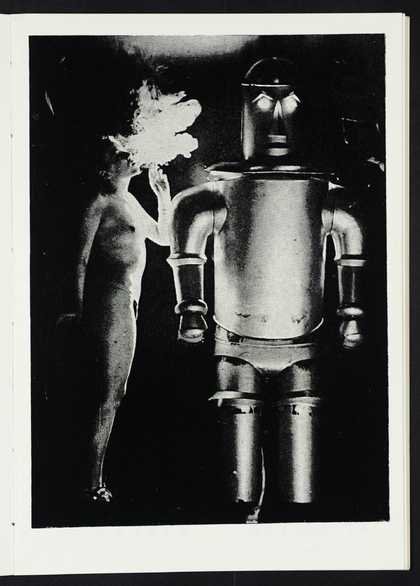
Sir Eduardo Paolozzi
[no title] (1962)
Tate
His first major work in this vein was the screenprinted book Metafisikal Translations 1962, although the preoccupation with engineered machinery and machine parts he displays here relates more to his earlier interest in discarded fragments of industrial manufacturing than to his subsequent experimentation with the look of electronic and mass media imaging. The Victorian roots of this technological vision are signalled through his use of woodblock prints from an old engineering manual, which he interspersed from time to time with more contemporary images of robots and parts from an internal-combustion engine. The text plays a leading role and takes the form of assemblages of word and phrase fragments excised from disparate sources. With its rhetoric of persistent yet disconnected iteration, its freewheeling, anarchic leaps of association, its Joycean neologisms and punning, its hard-edged materially saturated imagery, it operates in a similar mode to his previous commentary on his brutalist sculpture. The visuals, however, are more neutral and factual in tenor, and on occasion evidently comic in an off-hand casual way, with few overtones of dark satire. They are also for the most part straightforward replications of found printed imagery, unaltered readymades, as it were, not fabricated assemblages like the text. The visual possibilities of screenprinting are not exploited beyond giving the imprints of different kinds of source material a certain uniformity of look. Various industrially made objects and machine parts, sometimes stacked in loose arrays, alternate with the odd, abstractly-patterned shapes that might be stylised blueprints for a cased machine or a sculpture. The one image of a human machine is a tin pot robot, which exceptionally is taken from a photographic source (fig.3). What might have been on its own a slightly horrifying image of mechanised humanity becomes a rather ludicrous, almost toy-like apparition as a result of being juxtaposed with a casually smoking naked female lady. The effect of setting the sensuous flesh of a graceful posed figure against the simplified hollow metal forms and bolt-uprightness of the robot mocks the robot’s pretensions to achieving a simulated human presence, and undercuts any vision one might have of it as an inhuman threat.
At this juncture Paolozzi was working on a film, The History of Nothing, a dead-pan compilation of images from his scrapbooks analogous to the marathon presentation of such material he had given at the ICA. The notes for this filmed history of nothing – a ‘history of man … written with objects’ – were reproduced in Metafisikal Translations at the top of a page that featured the image of a spark plug (fig.4). The neat, mechanically engineered compactness of the latter contrasts strikingly with the freewheeling concatenation of heterogeneous materials in the text, ranging as these do from sculptures, modern machine parts, bodies of mythic figures, and stray bits of information. At the same time, the isolated, upright spark plug invites figurative associations – it is a kind of machine statue – that suggestively link it with the text:
The history of painting. The history of the object. The history of man can be written with objects.
All sculpture is a man-made object Machine as fetish Cylinder block Trojans column Laocoon
As votive the crankshaft erotic Segments of information19
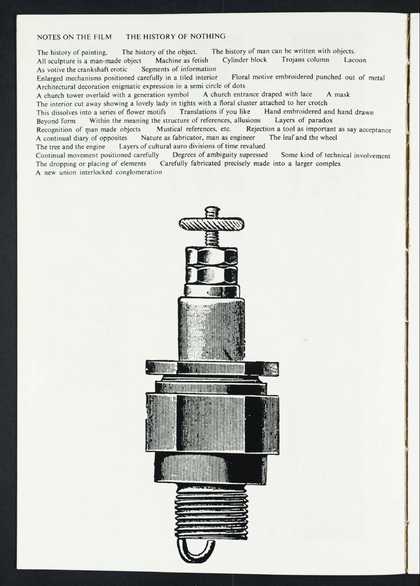
Sir Eduardo Paolozzi
[no title] (1962)
Tate
The Laocoön was a long-standing preoccupation of Paolozzi’s. It featured in a collage, literally enacting a concatenation of body and machine, later published in 1963 in a book titled The Metallization of a Dream, produced in collaboration with another ex-Independent Group member, the critic Lawrence Alloway.20 There Paolozzi’s fascination with unlikely juxtapositions of machinery, sculpture and human presence were given a dramatic twist in which intimations of disastrous collision were acted out in a decidedly slapstick mode.
Within this world of wildly disparate fragments, and stray but suggestive connotations, Paolozzi embedded some quite sophisticated meditations on the kind of art he was making and the processes of generation and fabrication it involved. In a passage lower down on the same page, he made mention of openness to a wide range of source material qualified by an insistence on selectivity, on rejection as well as acceptance.21 There is also a concern with precise fabrication and interlocking of disparate elements that is more technical than artistic, closer to engineering than the conventional formal logics of art:
Rejection a tool as important as say acceptance
A continual diary of opposites Nature as fabricator, man as engineer
The leaf and the wheel …
The mediation on technically, rather than purely aesthetically driven, processes of fabricating things from bits and pieces of ready made material continues on another page, after another flurry of images from Paolozzi’s archaic-modern techno-world (fig.5). Here, the text is accompanied by a very different kind of image. The latter features a stack of gears, nuts and other assorted metal parts in which the aggregate of discrete items has an effect rather closer in character to the array of verbal fragments in the text above:
Close up Space monkey Grinning Pathos Distorted lunatic cat Whiff of anti-war
Bottom of rocket Hybrid mutant boiler head attached to winged clown’s mask Hybrid in interior
Close up Ready made Technics room altered Hard diagonals Concave hexagons …
From Industrial design (US) Under water television Grappling device Philosophy round ready made as image
Collage ready made transformed or ready made altered Ready made Joined to invented section
Ready made enlarged22
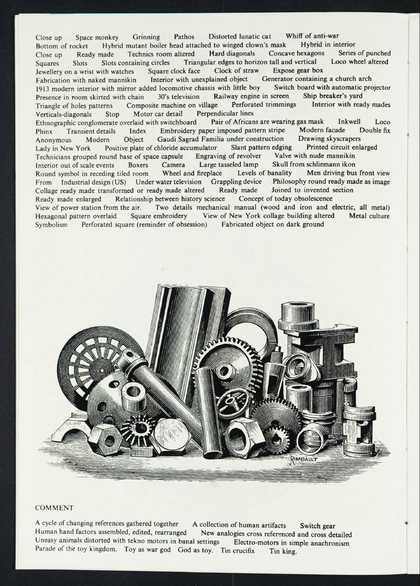
Sir Eduardo Paolozzi
[no title] (1962)
Tate
The term ‘as found’ deployed by Banham in his account of new brutalism is particularly relevant to Paolozzi’s thinking about his artistic project articulated here. While Paolozzi was clear about the important role played by found or readymade materials, he also insisted on the centrality of fabrication as having its own distinct imperatives. Found material was to be replicated but also transformed,23 often using mechanical means of duplication, and the reworked material would then be fitted into arrays that had their own structural, if aformal, logic. For him, foundness did not exclude fabrication, and openness to contingent, unpremeditated conjunctures was not incompatible with bringing to bear a generative structure of some kind. He had in mind an artistic process that would not be hamstrung, either by formalist orthodoxy or by a dada-esque cult of the readymade, one in which the structuring had a scientific and philosophical, rather than purely artistic, basis. This is exemplified more fully in the text of Metafisikal Translations than in the accompanying visual material, where a more conventional readymade aesthetic prevails. For a fuller visual playing out of such imperatives, one needs to turn to his slightly later, much more pictorial coloured screenprinted works, of which the series As Is When, a tribute to and meditation on the work of the philosopher Ludwig Wittgenstein, completed in 1964–5, is the most ambitious and richly invested.
Wittgenstein as model
The balance between text and image in the Wittgenstein series has shifted radically from Metafisical Translations, with the image being much larger and more intensively fabricated, and clearly dominating the text: the plates are almost picture size, measuring approximately seventy-five by fifty-five centimetres. Found elements are transformed by the complex colour registrations, mechanically varied in each printing, and by the iterative styling of the pictorial elements, enhanced by the integrating effects of the screenprinted flattening of variations in visual texture. Here, fragments of artist-made motifs are combined with selected bits and pieces of printed imagery. This is effected in such a way that it becomes very difficult to distinguish between elements, often significantly transformed, which have been sourced in the mass media and the patterns or motifs previously generated by Paolozzi himself. By contrast, the texts inserted into the margins of the images are not, as in Metafisikal Translations, collages of found and re-fabricated phrases and words. They replicate entire passages selected by Paolozzi from Wittgenstein’s writings, and from a well-known book published in 1956 containing a biographical sketch of Wittgenstein and a personal memoir written by an American ex-pupil and friend of the philosopher, Norman Malcolm.24 The memoir had helped make Wittgenstein something of a popular celebrity, with anecdotes detailing his eccentricities, his austere, reclusive lifestyle and his utter devotion to the life of the mind during his last years teaching in Cambridge. After his death in 1951, Wittgenstein became an intellectual hero in the English-speaking world, particularly in the early to mid-1960s. His ideas on language and its limits had an impact that extended well beyond philosophy, and even had a major effect on thinking about art.
Paolozzi’s series of twelve prints operates at two levels. First, there is the artist’s engagement with Wittgenstein’s distinctive mode of thinking, particularly as articulated in his earlier, and more analytic, Tractatus Logico-Philosphicus, published in 1921 (quotes from this in Paolozzi’s work are given in German as well as English). Second, there is Paolozzi’s interest in, and partial identification with, Wittgenstein’s predicament as someone trying to find his bearings in the modern world, a world shaped by war and mass media. The first print in the series, Artificial Sun 1964, carries the bald statement of principle that initiates the argument of the Tractatus: ‘The world is all that is the case’. The second print, Tortured Life 1964, is more biographical. Its text combines anecdotal material with statements from Wittgenstein’s earlier and later philosophical writing.
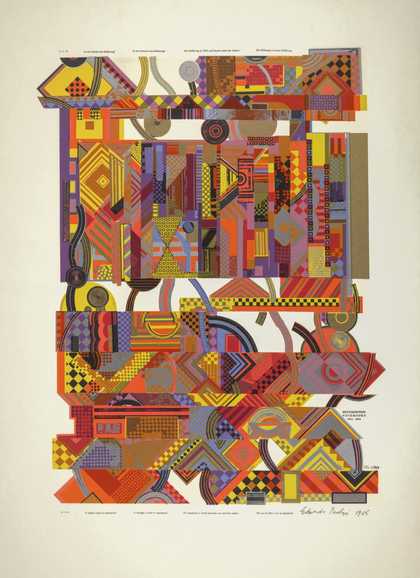
Sir Eduardo Paolozzi
Experience (1964)
Tate
The two most abstractly philosophical prints deal with fundamental questions about the nature of the exact knowledge we can have of reality – how we might deploy empirically verifiable, logical propositions to build up a picture of the world. The print Experience 1964 (fig.6) is accompanied by four laconic statements from Wittgenstein’s early notebooks in which he strictly separates out sensory experience of reality from subjective states of mind, and rigorously excludes from serious philosophical consideration the realm of so-called subjective experience:
Is belief a kind of experience?
Is thought a kind of experience?
All experience is world and does not need the subject
The act of will is not an experience
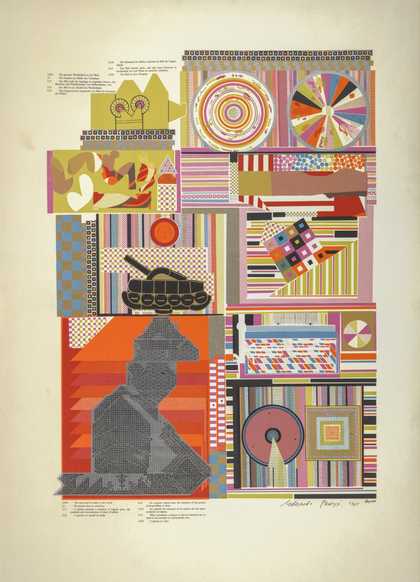
Sir Eduardo Paolozzi
Reality (1964)
Tate
What is involved in Paolozzi’s picturing of a Wittgensteinian understanding of experience?25 It can be seen as an attempt to visualise one’s experience of what Wittgenstein saw as the atomic, or as yet disaggregated, facts constituting reality before these were incorporated into propositional structures and formed into a picture of the world. The print’s assemblage of various abstract pictorial elements is not mere chaos, but neither are the individual elements clearly distinguished, nor are they articulated within some overarching structure as many of the elements or motifs are in the complementary print Reality 1964 (fig.7).
The text in Reality presents a barrage of tersely logical statements from the Tractatus concerning facts, reality and the picture model of the proposition – such that propositions present an exact model of ‘all that is the case’. Offered here is a radically condensed declaration of an entire system of thinking, its exactitude striking an attentive reader as perfectly clear, but also impenetrably terse, as does Paolozzi’s title for the series, As Is When – a puzzlingly spare declaration suggesting that any extant entity is simply what it actually is at a given moment in time. Wittgenstein’s slightly more elaborate, but still very compressed, formulation conveys the promise of gaining a totally logical grip on things, but also maintains a sense of the enormity and ultimate impossibility of this task:
2.063 The sum-total of reality is the world
2.1 We picture facts to ourselves
2.11 A picture presents a situation in logical space, the existence and non existence of states of affairs
2.12 A picture is a model of reality
Reality, in Paolozzi’s visualisation of it in this print, has a quite intricately articulated clarity and structure, but its overall sense remains perplexing, in a way that might be seen to parallel Wittgenstein’s presentation of his propositional modelling of reality. Paolozzi’s image is not reducible to any single stable form, and calls to mind the appearance of moving forms and motifs projected on a screen by a movie camera – an image of which is set alongside the German version of Wittgenstein’s text. There is, perhaps, a suggestion that the world of modern facts is best captured by way of technologies that register patterns of change and movement rather than simply being timeless mappings.
Paolozzi deploys Wittgenstein’s thinking about the world through language as a basis for constituting a structured sense of the world through a picturing made up of both abstract patterns and atomistically articulated motifs. With some motifs being representational and others not, the work also plays out the referential complexities of the pictorial languages available to an artist working at this time. Paolozzi was quite self-conscious about why Wittgenstein mattered to him. In an interview with Richard Hamilton soon after he had completed the series, he explained how, in working on these ‘collage prints’ as he called them, he discovered he could ‘give an extra edge’ to his work
by using Wittgenstein, connecting his language with each print; also I feel a certain kind of restlessness, which I betray in every sentence I utter; restlessness about the kind of words which are used around the image … I have a necessity to embrace some kind of language in relationship to the processes I’m involved with. And I find his the most sympathetic language. Some people need, perhaps, [Clement] Greenberg, I need Wittgenstein.26
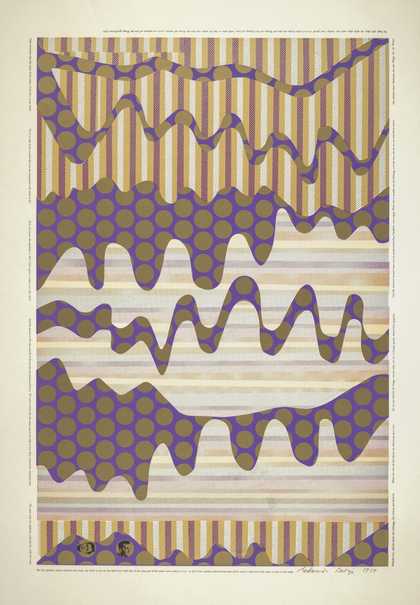
Sir Eduardo Paolozzi
The Spirit of the Snake (1965)
Tate
Wittgenstein’s commitment to a logically rigorous understanding of what we can and cannot know led him to some wonderfully mad flights of extreme logic, which, understandably, fascinated Paolozzi. The artist singled out the following text from Wittgenstein’s notebooks for the plate The Spirit of the Snake 1965 (fig.8):
Only remember that the spirit of the snake, of the lion, is your spirit.
For it is only from yourself that you are acquainted with spirit at all.
Now of course the question is why I have given a snake just this spirit.
And the answer to this can only lie in the psycho-physical parallelism:
if I were to look like the snake and to do what it does then I should be
such-and-such.
The same with the elephant, with the fly, with the wasp.
But the question arises whether even here, my body is not on the
same level with that of the wasp and of the snake (and surely it is so),
so that I have neither inferred from that of the wasp to mine nor from
mine to that of the wasp.27
Wittgenstein here is arguing that our understanding of the inner sprit we might assign to a snake comes entirely from our sense of our own inner spirit. We have no other basis for doing this – we cannot apprehend its inner spirit. We can only apprehend the living body from which we infer that the snake has a spirit animating it in a certain way. As our body exists on the same level of physical reality as that of the snake and wasp, when we think of the snake or wasp as having a spirit, he concludes, it must be the same as the spirit that inhabits our body. Something of this idea is echoed in the plate. Paolozzi has diminutive images of Wittgenstein’s head floating amidst the decorative patterning at the bottom of the plate. The thinking heads are enclosed within two of the scale-like dots that proliferate over the surface of the undulating snake forms.
A similar taste for situations where a strictly logical system issues in apparent absurdity displays itself in a passage Paolozzi selected from Bertrand Russell’s recollections of Wittgenstein for the print Tortured Life. When he was first in Cambridge, Wittgenstein took the strict view that propositions, as statements asserting a logically possible rather than an actual state of affairs, could not function as determinations of the actual existence or non-existence of an empirical phenomenon. Used to such purposes, he claimed, they made no sense. He was willing to take this point of principle to extremes that Russell joked about in the anecdote Paolozzi quotes. Russell apparently put to Wittgenstein the simple proposition: ‘“There is no hippopotamus in the room at present”. When he refused to believe this, I looked under all the desks without finding one; but he remained unconvinced.’28 Paolozzi’s fascination with the logical exactitude of scientific systems and procedures, and their potential absurdities, plays a part in the configuring of his prints, where the complex visual logic both encourages and subverts any attempt to assign them clear and stable meanings.

Sir Eduardo Paolozzi
Wittgenstein the Soldier (1964)
Tate
The biographical section of the text in the plate Tortured Life refers to Wittgenstein formulating his picture theory of propositions while in the trenches on the eastern front during the First World War, inspired by ‘reading a magazine in which there was a picture of the possible sequence of events in an automobile accident’. Here, again, Paolozzi’s fascination with the Laocoön is evident; he also titled the text that accompanied his Wittgenstein prints ‘Wild Track for Ludwig the Kakafon Kakkoon Laka Oon Elektrik Lafs’.29 Bearing this in mind, one might see affinities between the situation of the figure of Laocoön and the tormented life of the awkward automaton in the print, struggling with his gun/camera and a tangle of dangling wires or cords. A further print in the series, titled Wittgenstein the Soldier 1964, picks up on the theme of war via its representation of the philosopher in the Austrian army, when he would have been carrying his manuscript of the Tractatus in his rucksack (fig.9). What seems to be a large running Wittgenstein figure is set alongside a butterfly and a group of marching soldiers. While the figures’ outlines are quite naturalistic, their insides have been rendered as assemblages of machine parts. At one level recalling the disturbing or comic human-machine hybrids of Paolozzi’s earlier sculptures and drawings, the effect here is rather to suggest the utterly repetitive and robotic character of army life – from which the larger figure seems to be breaking away with its skipping, floating stance.
That the experience of war was, for Paolozzi, a particularly significant aspect of Wittgenstein’s life as a philosopher is clear from the text he fashioned as an accompaniment to the prints. This is a montage that intersperses passages from a variety of sources: a critical analysis of the Laocoön and the need in art to render the pregnant moment prior to a narrative climax; an article describing in elaborate technical detail the arrangement of a shooting location for a film; a report on air combat which ends with a fighter plane shooting down a bomber; and a report on another war incident involving soldiers on an exhausting desert march. This is a mad text – it is almost impossible to follow the dispersed fragments of different narratives as they flow seamlessly, yet illogically, into one another. The tenor of the conclusion is fairly clear, however, and relates in a pointed way to the image in the print Tortured Life. The passage starts with the concluding moments of the air combat, accompanied by music from the film shoot scenario:
He heeled down and got into a vertical dive. He was almost four hundred yards behind the bomber when he opened fire. He saw pieces of fabric disintegrate, saw the bomber weave fantastically and then a plume of black smoke issue from the starboard engine. Tympani roll with Cymbal in unison. Rhythmic Tymps with Tambourine background. He did not paint Medea at the moment of her actually murdering her children but just before. What he thinks and knows. How to find fictional correlatives for his beliefs. The result is so violent as to extort a scream, either soon abates or it must destroy the sufferer.30
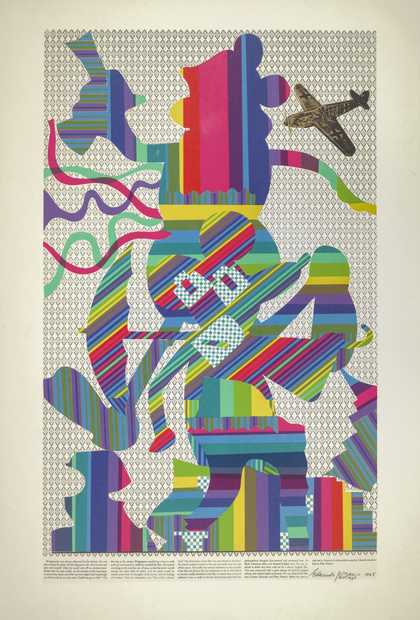
Sir Eduardo Paolozzi
Wittgenstein at the Cinema Admires Betty Grable (1965)
Tate
Other experiences of the larger world are evoked in a print about Wittgenstein’s arrival in New York on a trip he took shortly before he died, his one direct (rather than filmic) experience of American modernity, and a further print dealing with his love of commercial Hollywood film, Wittgenstein at the Cinema Admires Betty Grable 1965 (fig.10). The image in the latter print presents fragments of popular film culture taken from several sources, including Mickey Mouse cartoons, war films and gangster films, and possibly featuring a striding silhouette of Wittgenstein’s favourite movie star, Betty Grable, who was famed for her ‘million dollar legs’. The text quotes an anecdote from Norman Malcolm’s biography which relates how Wittgenstein, exhausted after finishing a lecture, would often rush to see whatever Hollywood film might be showing in the local cinema. He made sure to sit in the front row ‘so the screen would occupy his entire field of vision’ and could clear his mind of ‘the philosophical thoughts that tortured and exhausted him’.31 With its overlaying of disparate image fragments, the plate’s structure suggests the streaming of images in the cinema, as well as the state of distraction this spectacle might induce if it filled one’s entire field of vision.
The final print in the series, He Must, So To Speak, Throw Away the Ladder 1965, takes one back to philosophy, quoting the most richly invested and perplexing passage in the Tractatus, the conclusion where Wittgenstein enjoins his reader: ‘My propositions serve as elucidations in the following way: anyone who understands me eventually recognizes them as nonsensical’. Then comes the potent and much quoted final sentence: ‘What we cannot speak about we must pass over in silence.’ A passage from a 1972 interview with Paolozzi encapsulates rather well what was at stake in his investment in Wittgenstein’s way of thinking and existential predicament:32
Realistic artistic comprehension looks the facts in the eye and shows the best possible reality. The world has an objective structure described in the information or evidence supplied, but in addition the strength of the expectations depends on the personality of the man who weighs the evidence and makes a synthesis in the Hegelian sense of the imitation of nature in its accidental forms on the one hand and of humour on the other.33
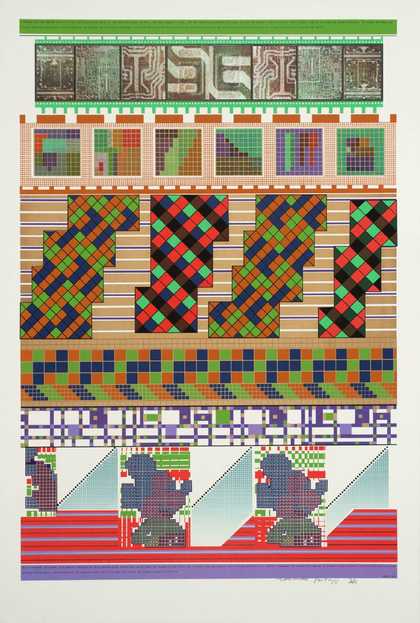
Sir Eduardo Paolozzi
A Formula that can shatter into a million glass bullets (1967)
Tate
The process of weighing the evidence, the information that is given, and then making a synthesis that involves ‘the imitation of nature in its accidental forms on the one hand’ and ‘humour on the other’ amounts to as good a statement as one might hope to have of the approach Paolozzi took in his more ambitious and resonant works. The reference to Hegel is hardly beside the point. Hegel saw humour as the characteristic mode of art in a modern world where the artists’ materials had become the contingencies of existence rather than collectively sanctioned symbols of the kind available to art in earlier periods.34
Mass media and technological systems
Paolozzi’s subsequent print series took on different issues – the new systems being generated by electronic technology and computing, for example, as well as the ever proliferating image world of mass media advertising and news. Universal Electronic Vacuum 1967 is the more systems-orientated of these, riffing on the image-making capacities of the latest electronic technology and looking to a future of computer-generated images. The visual layouts suggest the generative possibilities of strictly controlled iterative systems and the pattern- and image- streaming to which the new visual technologies might give rise, but they are also suggestive, as Paolozzi put it, of an electronic vacuum. Such themes are taken up quite literally in the textual montage that runs along the bottom of the print A Formula That Can Shatter Into A Million Glass Bullets 1967 (fig.11):35
a formula that can shatter into a million glass bullets … a whole animated instructional picture showing rolling balls, the operation of the computer itself and titles that rise across the screen, expand and dissolve … pictures of Mickey Mouse’s head as seen from any chosen direction.
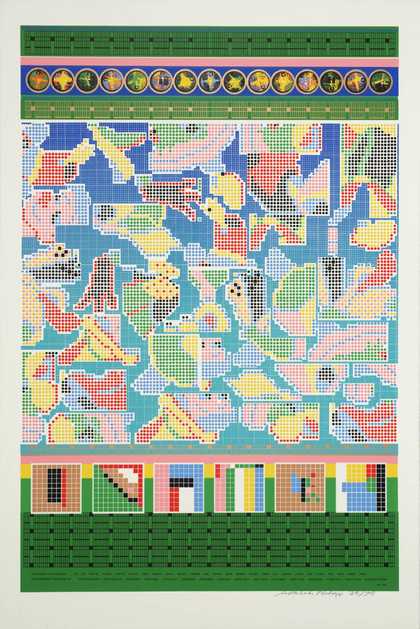
Sir Eduardo Paolozzi
Spontaneous Discrimination Non-Spontaneous Discrimination (1967)
Tate
Both text and image evoke the generative, disintegrative and also levelling possibilities of a continuously streamed, electronically generated world of pattern and image, playing upon effects achieved in film and television, while also seeking to imagine the look of the new kinds of visual environment that a thoroughly automated computer system might produce. It is important to remember that at this stage computer-generated imagery was more a possibility than a reality. The technology was very much in its infancy and the output from computers was not yet directly delivered on electronic monitors as screened images. In the plate Spontaneous Discrimination Non-Spontaneous Discrimination 1967 (fig.12) the flickering pattern of decomposing and reconfiguring motifs forms a matrix on which variously open or closed procedures of discrimination might be tested out. Paolozzi seems to be registering here a fascination and an unease over the endlessly variegated, yet also repetitive, permutations to which a systems-orientated production of visual material might give rise, whether actually computer-based or simply echoing contemporary interest in automatically regulated systems operating without any direct human input.
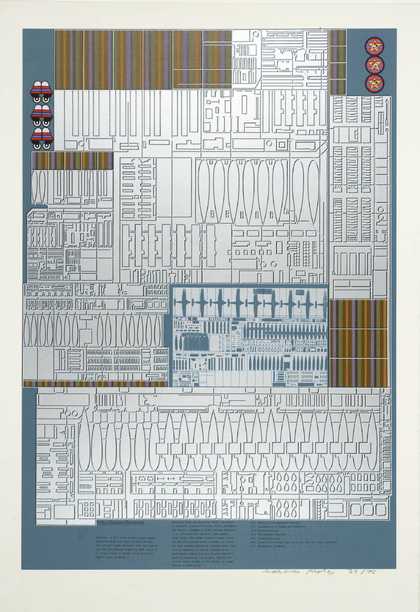
Sir Eduardo Paolozzi
War Games Revised (1967)
Tate
The very real threat posed by the mindset embedded in these new technologies is addressed in the print War Games Revised 1967 (fig.13). The reference to computerised war games calls to mind the American and Soviet militaries’ virtual worlds of elaborately automated systems designed to program in advance for a possible nuclear attack. The text quoted at the bottom of the image, taken from what would seem to be a military handbook, touches on topics such as ‘Abortion – a kill which prevents the enemy targets from proceeding with their tactical mission. The attacker’s game theorist, then has figured out that the attacker stands the best chance if he allows chance to decide, using two-to one odds in favour of sector 2’. The utterly logical illogicality of this virtual world – its coolly inhuman, completely disengaged gaming with the possibility of nuclear annihilation – is echoed in the sanitised diagram of relentlessly replicating military hardware in the image, and the schematic logic of its clinically abstract, dematerialising visual rhetoric.
A rather different approach is taken in the two more loosely conceived and expansive series of prints Paolozzi issued in 1967 and 1970, the first titled Moonstrips Empire News, and the second, entitled General Dynamic F.U.N., being billed as Volume II of Moonstrips Empire News.36 The plates here are slightly smaller, about forty rather than seventy-five cm high, but still sizeable. All those in the first series are screenprints, while several in the second series experiment with photolithography and the possibilities this offered for creating semi-translucent overlayering, as well as less sharply defined forms. These series engage with imagery and texts circulating in the modern mass media, although they are different from most pop art because of their extensive textual material and their broad purview, which extends well moving beyond most pop artists’ focus on advertising and publicity images. While their general tenor seems quite laid-back, they are at the same time self-consciously and pointedly satirical. As Paolozzi put it in a conversation recorded in 1966, ‘I think that the words [to describe experience] have all sort of collapsed. The only possibility is satire now. Either you turn your back on everything or you do something powerfully satirical.’37
The prints, 100 in one series and fifty in the second, come in boxed sets that can be arranged in any order, and the material presented can at first seem quite randomly chosen. However, suggestive patterns and themes do emerge in the proliferation of differently patterned formats, and text and image montages. The satires range from playful subversions of pulp romance – in one case, a couple’s clichéd embrace is paired with advertising for a Die Casting Plant – to the mass media’s exploitation of the aura associated with masterpieces of high art, as in the print The Silken World of Michelangelo 1967 (fig.14). In such works, Paolozzi continued to exploit his fascination with machinery, technological processes and visual morphology, as well as his long-standing preoccupation with visualising amalgamations of the human and the mechanical that were pervasive in the culture of the time. Some astute visual commentary is offered on the mass media’s elaborately contrived presentations catering to consumer desire. The print Mumbling and Munching to Muzak 1967 (fig.15), for example, parallels the packaging of the female body in fashion imagery with the packaging of cocktail foods in elaborately crafted containers made of hollowed-out cabbages. Other satires have a darker aspect – in one, a blandly pretty presentation of child-related imagery is cross cut with a title taken from a sensationalising taster in a pulp magazine: ‘Why children commit suicide … read next month’s edition’. The print here draws upon the anodyne visual pabulum generated by children’s shows on television, at the same time that it plays to excess the artificially enriched consumer world of food advertising.

Sir Eduardo Paolozzi
The Silken World of Michelangelo (1967)
Tate
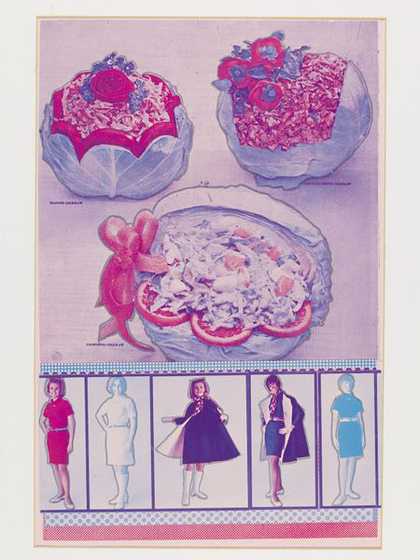
Fig.15
Eduardo Paolozzi
Mumbling and Munching to Muzak (from the series General Dynamic F.U.N.) 1967
Victoria and Albert Museum, London
© The estate of Eduardo Paolozzi
At one level, there is a random-seeming concatenation of disparate material and deadpan, de-subjectivised presentation that is the hallmark of the popular media from which Paolozzi’s material derives. At the same time, there is also the sense of a mind at work selecting material, setting up intriguing interconnections of a kind that the media itself might accidentally create but glosses over, as well as an ironic perspective that the source materials in their original context would singularly lack. Paolozzi was quite explicit that he was not just recycling readymade material, even while insisting on this material’s factual status as input from the larger media world. The elements taken ‘as found’ are subjected to processes of selection and mechanical transformation, and then incorporated into generative patterns devised by the artist. As he explained in conversation with his friend J. G. Ballard, the mere fact of presenting a found image in a print
means that you have to look at this image in a much more serious way than you would if you just found it in the pages of Time or Newsweek. But it has to be a particular image; one chooses from three thousand which one has collected over the years … one’s looking at … images involved in a kind of global situation, and one’s choosing an image which acts as a metaphor for one’s particular feeling. But unless one emphasises and arranges the images into patterns of irony the point will be lost.38
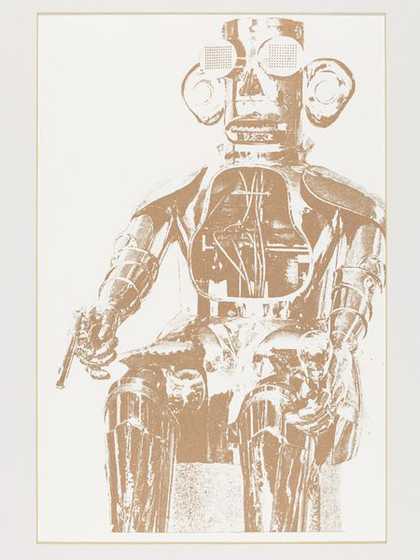
Fig.16
Eduardo Paolozzi
No Heroes Developed (from the series General Dynamic F.U.N.) 1967
Victoria and Albert Museum, London
© The estate of Eduardo Paolozzi
Both Paolozzi’s way of working and the image world he was conjuring up at this stage have moved a very considerable distance from his earlier work in a brutalist mode, more so perhaps than the series Metafisikal Translations or As Is When. His riff on the consumer-orientated rhetoric of the modern mass media in Moonstrips Empire News is more akin to pop art, more a direct processing of given images from the modern world of consumer culture. At first, one might be inclined to see a straight difference here with his earlier work, like the conventional duality between pop and brutalism. But confronting the print No Heroes Developed 1967, from General Dynamic F.U.N. (fig.16), with the sculpture St. Sebastian No.2 1957 should make one pause before giving in to such clear-cut polarities. The robotic killing machine, with breastplate removed to reveal a hollow mechanical inside, may be more high-tech, more in tune with the smoothly imaged world of the modern mass media, than the ravaged archaic hulk, but it is no less sinister – and perhaps more so because of its affinities with the cyborg imaginary beginning to feature in science fiction and horror films. Just as pop currents are evident in the new brutalist mindset of the participants in early Independent Group initiatives, this comparison brings out quite clearly the presence in Paolozzi’s later, more pop-like work of a sense of brutalist fault lines and disturbances within the flattened out rhetorics of a media and techno-systems orientated world. If anything, the later work can be more haunted by the violence and potential for atrocity inherent in modern culture. At the same time, there is in both his earlier and later work a bracketing out of easily resonant, affect-laden subjective response to what Paolozzi saw as the present-day ‘human predicament’.39 A certain ironic detachment combines in his case with an intellectually sharp engagement with things. There is also an ongoing fascination with rational-seeming structure and system, and their irrational capacity to go wildly awry, which is integral to his approach as an artist, both in his more brutalist beginnings and his later work sourced from mass media.
